In this article, you’ll learn what is Rolling mill and how it works and 6 types of rolling mills with explained with images. Also, you can download the PDF file of this post.
Rolling Mills and Types
Rolling mill is an extensively used process and the most expensive one in terms of equipment costs. It accounts for almost 90% of the metal produced by forming.
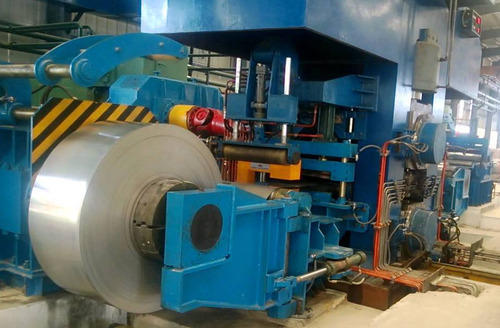
In the rolling process, the job is drawn through a set of rolls due to interface friction, and the compressive forces reduce the thickness of the workpiece or change its cross-sectional area.
The types of rolls used in rolling mills are depended upon the shape, size, and the gap between the rolls and their contour. Because of workability and limitations in equipment, rolling is done in the following steps, that is a number of passes through the rolls may be required to get the required configuration.
During rolling initial passes results in a reduction of cross-sectional area, while intermediate passes try to bring the shape closer to the final shape and the final or finishing passes bring the material to the required shape and size. Plates, bars, rounds, structural shapes, sheets, and strips can be obtained by rolling.
Here are some similar articles you can check out:
- Heat treatment: Types, Working, and Process of Heat Treatment
- Metal Casting Process: Types of Moulding, Sands and Its classification.
- What are the types of Electric Motors? Their Working & Applications
Types of Rolling Mills
Following are the 6 different types of rolling mills used in many industries:
- Two high rolling mills
- Three high rolling mills
- Four high rolling mills
- Cluster rolling mills
- Planetary rolling mills
- Tendem or Continuous mills
1. Two High Rolling Mills
It contains two heavy rolls fixed one over the other. The rolls are supported in bearing housed in sturdy upright frames (called stands) which are grouted to the rolling mill floor. The vertical gap between the roll is adjustable. The rolls rotate in opposite directions and are driven by electrical motors.
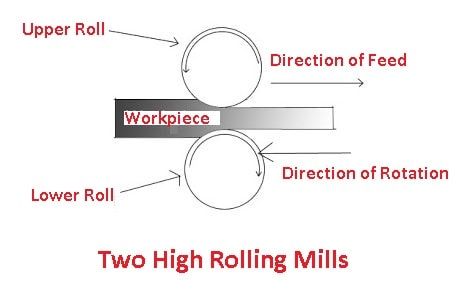
The direction of rotation of rolls cannot be changed, therefore the work has to be fed into rolls from one direction only. If rolling requires more than one ‘pass’ in the same set of rolls, the material will have to be brought back to the same side after the first pass.
2. Three High Rolling Mills
It consists of three rolls positioned directly over one another as shown in the figure below. The direction of rotation of the first and second rolls are opposite as in the case of two high mills. The direction of rotation (path) of the second and third rolls is always opposite to each other.
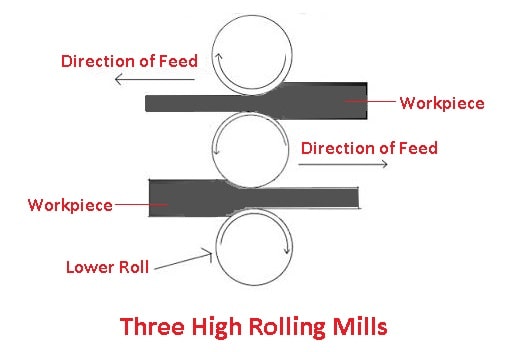
Always all three rolls rotate in their bearings in the same direction. The advantage of this will mill is that work material can be fed in one direction between the first and second rolls and the return pass can be provided between the second and third rolls. This results in the transport of material from one side of the rolls to the other.
Read also: List of Mechanical Properties That Every Mechanical Engineer Should Know
3. Four High Rolling Mills
The mill has four horizontal rolls, two smaller diameters and two much larger. The larger rolls are called backup rolls. The smaller rolls are the working rolls, but they would be thicker in the center and thinner at either end.

Backup rolls hold the working rolls and restrict deflection when the material is being rolled. The usual products of these mills are hot and cold plates and sheets.
4. Cluster Rolling Mill
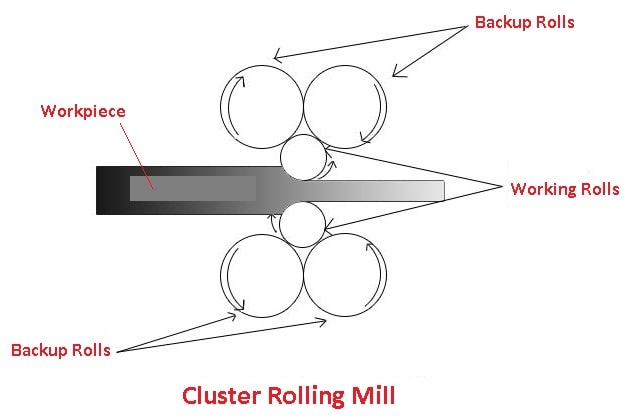
It consists of two small diameter working rolls and four or more backing rolls. The larger number of backup rolls provided becomes necessary as the backup rolls cannot exceed the diameter of working rolls by more than 2-3 times.
5. Planetary Rolling Mill
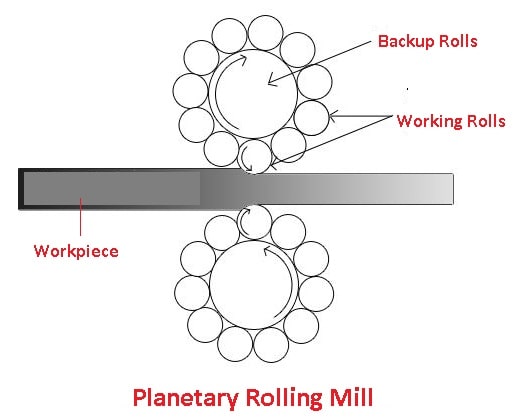
In the planetary mill type of rolling machine, a large backup roller is surrounded by a number of planetary working rollers as shown in the figure.
Each planetary roll gives a continuous reduction. It is employed to reduce large thicknesses in a single pass of a steel strip. Its rolling capacity is higher than a cluster machine but less than a tandem rolling machine.
6. Tandem or Continuous Mill
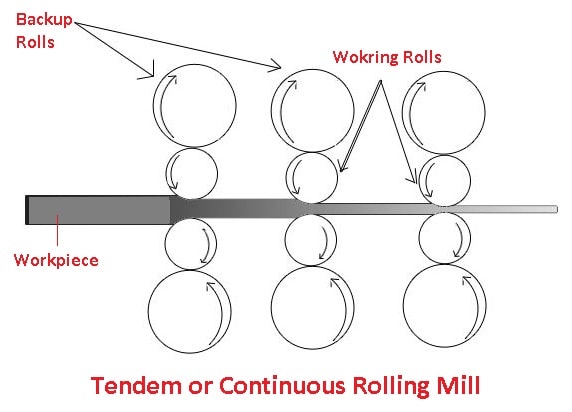
In this tandem mill types of rolling mills, It includes a number of non-reversing two-high rolling mills provide one after other. So that the material can be passed through them all in order.
This is only suitable for mass production work, as lower volumes require a quicker change of set up and they will consume a lot of labor and work.
Conclusion
So now, we hope that we have cleared all your doubts about the Types of Rolling Mill. If you have still any doubts about the “Types of Rolling Mill” you can contact us or ask in the comments.
That’s it thanks for reading. If you like our article then please share it with your friends. If you have any questions about any topic you can ask in the comment section.
Subscribe to our newsletter to get notified when we upload new posts.
Download the PDF file of this article:
Read Next: